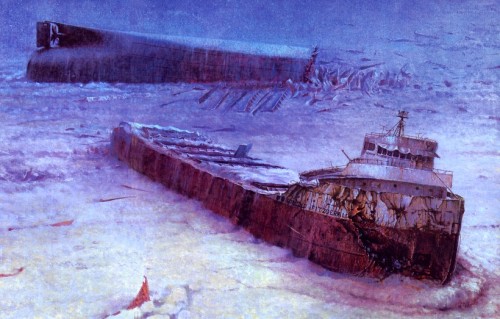peashooter85:38 Years Ago Today —- The Sinking of the Edmund Fitzgerald,At over 700 feet long and wi
peashooter85:38 Years Ago Today —- The Sinking of the Edmund Fitzgerald,At over 700 feet long and with a dead weight tonnage of 26,000, the SS Edmund Fitzgerald was the largest freighter of the Great Lakes in the 1960’s and 70’s. However the Edmund Fitzgerald would go down in history as a doomed ship, its fate foreshadowed when it took three blows to break a champagne bottle on her bow at her christening. From 1958 to 1975 the Edmund Fitzgerald hauled talconite ore from mines in Duluth, Minnesota to iron and steel mills in Detroit, Toledo, Buffalo, and other Great Lakes ports.On November 9th, 1975, the Edmund Fitzgerald set off on a run from Superior, Wisconsin to a steel mill in Detroit. The next day the Edmund Fitzgerald was caught in one of the worst storms in Great Lakes history, with waves over 35 feet high and hurricane force winds. At 3:30 PM the Fitzgerald reported that it had sustained topside damage and was heading for safe port in Whitefish Bay, Canada. 40 minutes later the Fitzgerald requested radar assistance from a nearby ship, the Anderson, as she had lost radar capability. By 6:00 PM the Fitzgerald reported,”"I have a bad list, lost both radars. And am taking heavy seas over the deck. One of the worst seas I’ve ever been in.“ The Anderson continued to guide the Fitzgerald into Whitefish Bay, until it was itself struck by a large wave and force to seek safe harbor. At 7:00 PM the Fitzgerald made sent its last radio signal reporting, “we are holding our own.” By 7:30 the Fitzgerald had disappeared from radar screens and no longer responded to radio calls.The Edmund Fitzgerald took all 29 crew with her, leaving nothing behind but an oil slick and some assorted pieces of wreckage. Four days later the wreck was located 530 ft below Lake Superior. She was only 15 Nautical Miles from Whitefish Bay and safety. Over the coming decades the wreck has been studied and surveyed, with numerous theories offered as to the reason for its sinking. The most prominent feature of the wreck is the fact that it had been ripped in half, either before of after its sinking. It is often suggested that the Fitzgerald was overloaded, causing large waves to create stress fractures on the Fitzgerald’s hull. Numerous other factors are to blame for the Fitzgerald’s sinking. After the sinking of the Edmund Fitzgerald the Mariners Church in Detroit started the tradition of wringing its bells 29 times, in honor of the 29 dead crewmen. They are as follows,McSorley, Ernest M. CaptainMcCarthy, John H. 1st MatePratt, James A. 2nd MateArmagost, Michael E. 3rd MateHoll, George J. Chief EngineerBindon, Edward F. 1st Asst. EngineerEdwards, Thomas E 2nd Asst. EngineerHaskell, Russell G. 2nd Asst. EngineerChampeau, Oliver J. 3rd Asst. EngineerBeetcher, Frederick J. PorterBentsen, Thomas OilerBorgeson, Thomas D. AB Maint. ManChurch, Nolan F. PorterCundy, Ransom E. WatchmanHudson, Bruce L. DeckhandKalmon, Allen G. 2nd CookMacLellan, Gordon F. WiperMazes, Joseph W. Spec. Maint. ManO’Brien, Eugene W. WheelsmanPeckol, Karl A. WatchmanPoviach, John J. WheelsmanRafferty, Robert C. StewardRiippa, Paul M DeckhandSimmons, John D. WheelsmanSpengler, William J WatchmanThomas, Mark A DeckhandWalton, Ralph G. OilerWeiss, David E. Cadet (Deck)Wilhelm, Blaine H. OilerI almost forgot, six days ago today was the 39th anniversary of the sinking of the Edmund Fitzgerald. -- source link

